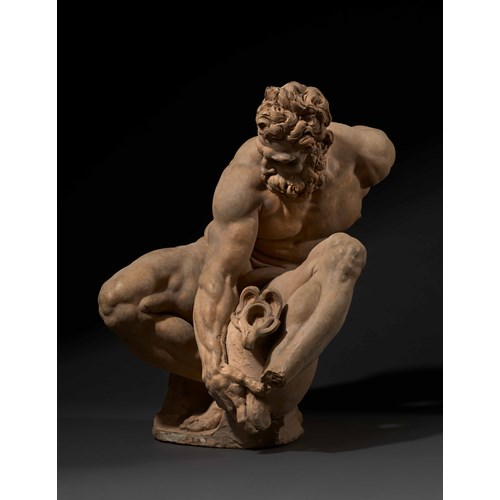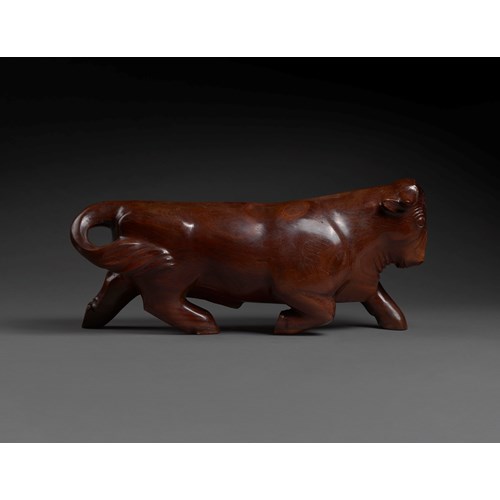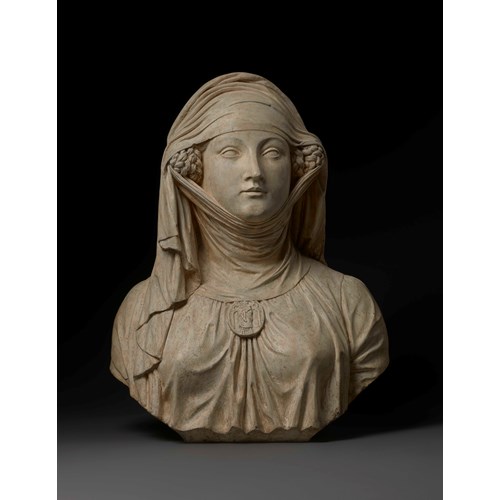Emmanuel Frémiet
St Martin Dividing his Cloak
Date Circa 1880
Dimension 45 x 33 cm (17³/₄ x 13⁰/₁ inches)
In approximately 1880, Frémiet’s eye turned to St. Martin; the 4th century Roman soldier who converted to Christianity after an encounter with a half-naked beggar in the city of Amiens in northern France. Martin cut his cloak in half in order to clothe the beggar, who that night appeared to him in a dream, revealing himself to be Christ. This experience so affected Martin he renounced the army and become a devotee of Christianity. After his death, St. Martin became the patron saint of France; symbolising charity and both religious and national pride.
Central to the cult of St. Martin was the relic of the remaining half of his cloak. It was deemed to be so important that the kings of France used it as a royal banner in war, and they swore sacred oaths upon it. The structure in which the half-cloak was preserved was referred to as cappella (‘little cloak’), a term that became widely used for buildings that served to keep relics and from which the modern word ‘chapel’ is derived.2 Subsequently, this terracotta example executed by Frémiet was likely used for private devotion, possibly in a small chapel or domestic setting, rather than as a civic monument. Intriguingly, Frémiet includes the use of a fleur-de-lis as a heraldic device, showing his desire to depict St. Martin not just as a religious figure, but of wider importance, as a symbol of French patriotism and unity. Importantly, this coincides with the attitude of government at the time, known for its ‘Moral Order’ and program of rule according to religious principles and the restoration of the monarchy.3
It follows in the wake of the Franco-Prussian War in 1871 and deposition of Napoleon III, where France suffered a crushing defeat at the hands of the Germans, resulting in the loss of two of its cherished eastern territories: Alsace and Lorraine. This was compounded by the destruction caused by the Paris Commune, where the Louvre Palace and Town Hall were burned to the ground, with the column of the Place Vendôme toppled. France was in dire need of symbols to heal its wounds of humiliation and to help erase them from collective memory. State sponsored sculptures with themes of redemption and re-conquest began proliferating within the capital's public squares.
The religious revival of the 19th century, provoked by the war, saw the regeneration of religious art, particularly monumental paintings, sculpture and stained glass.4 This included, in particular, the figure of St. Martin. The State commissioned painters from the Salons to depict images of the saint, placing them in the churches dedicated to him. All of these artists were contemporaries of Frémiet and helped spread the legend of the saint. 5 It is therefore hardly surprising that Frémiet himself was also inspired by this religious revival. With this sculpture, he contributed in his own way in reproducing the legend of the gift of the cloak. But rather than an ostentatious sculpture, he chose here a format and style conducive to private devotion and pathos. The beggar in this scene is war- wounded on crutches, his leg missing; a commentary on the brutality of the war at the time. The figure of St. Martin is dressed in medieval French, rather than Roman attire, and is shown supporting his fellow man. Frémiet uses these historical metaphors to brilliantly illustrate his attitude to the appalling loss of life and the maiming of thousands of victims of war.
Directly inspired by the manuscripts of the medieval era in its sumptuous use of polychrome, gold and inlaid lettering, this original terracotta is a unique sculpture, intended for private piety and contemplation. The colours used are vivid yet subdued, creating an ethereal quality that lends itself to religious themes. It is the oeuvre of a sculptor known for his passion for history and for his documentary research undertaken as a veritable quest, as was the case for his prolific models of Joan of Arc on Horseback (1874) and Saint Gregory of Tours (1878).
1 ‘La main et le multiple’, C. Chevillot.
2 ‘The cloak of St Martin of Tours’, The British Library.
3 ‘Architecture and Popular Religion: French Pilgrimage Churches of the Nineteenth Century’, page 271.
4 Ibid, page 24.
5 ‘La légende de saint Martin au XIXe siècle’, exhibition catalogue.
Date: Circa 1880
Signature: Signed E. FREMIET
Dimension: 45 x 33 cm (17³/₄ x 13⁰/₁ inches)
Provenance: Private collection, France, to 2024
Literature: ‘The cloak of St Martin of Tours', 11th November 2018, Medieval manuscripts blog, The British Library.
Chevillot, C. ‘Emmanuel Fremiet: ‘La main et le multiple’, exhibition catalogue, Musée des Beaux-Arts, Dijon, 1988–9, p. 23.
'La légende de saint Martin au XIXe siècle’, exhibition catalogue, various authors, Musée des Beaux-Arts de Tours, October 22 1997, January 12 1998.
Basciano, J.R. ‘Architecture and Popular Religion: French Pilgrimage Churches of the Nineteenth Century’, Columbia University, 2012, pgs 24-272.
More artworks from the Gallery









